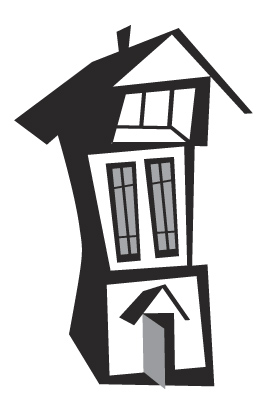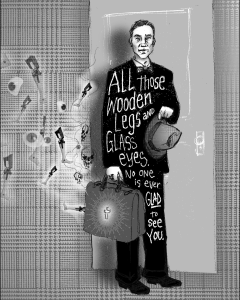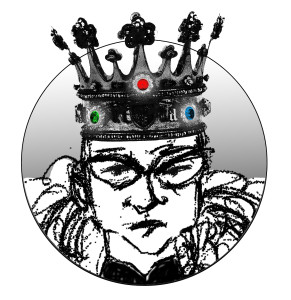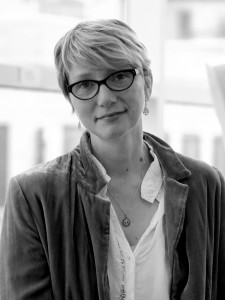 RITA MAE REESE is the author of The Alphabet Conspiracy and a recipient of numerous awards, including a Rona Jaffe Foundation Writers’ Award, a Stegner fellowship, a “Discovery”/The Nation award, and a Pamaunok Poetry Prize. Her most recent book, The Book of Hulga, won the Felix Pollak Prize and will be published by the University of Wisconsin Press in March, 2016. She is the co-director of Literary Arts at Art + Literature Laboratory in Madison, WI. Visit her at ritamaereese.com. (Photo credit: Amanda Crim) RITA MAE REESE is the author of The Alphabet Conspiracy and a recipient of numerous awards, including a Rona Jaffe Foundation Writers’ Award, a Stegner fellowship, a “Discovery”/The Nation award, and a Pamaunok Poetry Prize. Her most recent book, The Book of Hulga, won the Felix Pollak Prize and will be published by the University of Wisconsin Press in March, 2016. She is the co-director of Literary Arts at Art + Literature Laboratory in Madison, WI. Visit her at ritamaereese.com. (Photo credit: Amanda Crim)
About the Illustrator: Julie Franki has written and illustrated independent comics, designed historical exhibits, designed and illustrated greeting cards and more for Hallmark, Inc., and designed many brand identities including the Dane County Regional Airport logo (her personal favorite). She lives in Madison, Wisconsin. |
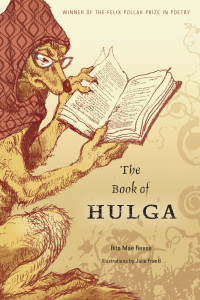 Book Title, Press, Year of Publication:
Book Title, Press, Year of Publication:
The Book of Hulga, University of Wisconsin Press, 2016
Synopsis: The Book of Hulga speculates—with humor, tenderness, and a brutal precision—on a character that Flannery O’Connor envisioned but did not live long enough to write: “an angular intellectual proud woman approaching God inch by inch with ground teeth.”
What do you think makes your book (or any book) a “project book”?
With my first book, I really wanted to just have a collection of what I felt my best poems were at the time. I thought project books meant that it wasn’t necessarily all of the poet’s best work, just the things that matched the theme and/or form, sort of like how Goodwill groups all of the red shirts together. I was afraid that there would be something arbitrary and unnecessarily limiting in having a cohesive vision for the whole book. Now I think that was, to be generous, naïve (to be honest, I think it was stupid). So now I think of a project book as a collection of poems that have something more obvious in common than the fact that the author wrote all of them. One of the things I really value in poetry is repetition—a returning over and over to an idea to get at the real meat of it, and that’s what I feel like great books of poetry, particularly great project books, accomplish.
Why this subject (or constraint)?
My nine-year-old daughter has asked me this question several times, and I don’t think I’ve ever managed to answer it either to her satisfaction or my own. I became obsessed with Flannery O’Connor when I first read one of her stories in college. It was like a splinter that got lodged very deep, and over the years I would find more things that connected to her. I would also begin to understand more behind and around her stories. I think I was definitely one of the people she had in mind when she said, “For the blind you draw large and startling figures.” She got my attention with those figures—the Misfit, Hulga, Manley Pointer, Mrs. Greenleaf, Mary Grace with her hurled textbook—and then she kept my attention with the depth of meaning that was packed into each story. I also fell in love with her collected letters, The Habit of Being, which led me to a lot of other great writing.
Are you comfortable with the term “project book”?
I suppose that depends on who is labeling it that and what their motives are. I think it is a very useful and accurate label, but like anything else it can be used to keep certain people out of a restricted area, such as the restricted area of serious literature. So I guess I’m saying I might have issues with how some people use the label, but not with the label itself.
Was your project defined before you started writing? To what degree did it develop organically as you added poems?
I thought it was very well defined until I actually started writing it. I had a list of poems that would go in the book and everything. The early poems were really terrible; I felt so horribly self-conscious about writing about Flannery O’Connor. I gave a reading in Milledgeville, Georgia that included a poem about her death, and O’Connor’s cousin, Louise Florencourt, was in the audience. I saw her face as I was going back to my seat and she looked exposed and stricken, and though I felt real grief over O’Connor’s death, I realized that she wasn’t public property—that there were still people alive who had known and loved her, and I felt a responsibility toward them. It was terrible. And then I remembered what I really wanted to write about was a vision of O’Connor’s. She had written, “If I were to live long enough and develop as an artist to the proper extent, I would like to write a comic novel about a woman—and what is more comical and terrible than the angular intellectual proud woman approaching God inch by inch with ground teeth?” This comment was made in the context of a conversation about Simone Weil, but she clarified in the next letter, “My heroine already is, and is Hulga.” Hulga is the main character from “Good Country People,” a woman with a wooden leg and a PhD in philosophy who attempts to seduce a bible salesman. Once I realized that Hulga was the key—a sort of bridge between Weil and O’Connor and also a way of seeing O’Connor without trespassing on what I felt to be private property—the book seemed to just happen.
How important was it for you that each poem could “stand on its own” or that the poems should rely on other poems in the book, or on the premise of the project itself, to succeed? What challenges did this present for you when writing single poems or structuring the book overall?
I really didn’t care very much if the poems stood on their own. Early on, I decided not to send them out to journals except in cases where someone had asked to see work (with a couple of exceptions along the way) because I didn’t want to think that poems that were accepted were better than ones that weren’t. I was really afraid outside opinion would cloud my judgment, and so I saw the poems as all sinking, or swimming, together.
At any point did you feel you were including (or were tempted to include) weaker poems in service of the project’s overall needs? This is a risk, and a common critique, of many project books. How did you deal with this?
I don’t think I felt tempted to include weaker poems because they belonged to the project. I’m sure I have included weaker poems, but I did it because I like them. I was having so much fun writing the book that I wish I were still writing it, so I didn’t feel tempted to include poems just to reach that magic 48 page number (though once the manuscript got there, I did relax a bit).
Did you fully immerse yourself in writing this project book, or did you allow yourself to work on other things?
Everything seemed to relate to Hulga as I was writing the book—I saw her in everything, so I couldn’t really work on anything else, it would just come out Hulga anyway.
Did you ever lose momentum, bore yourself, or worry that your project could not be sustained for a full-length book? How did you push through?
When I was working on Hulga, I liked to joke about how I was collaborating with the dead—and it was great because they couldn’t object to any of my decisions. It made me realize ,though, that I was interested in collaboration, that even working with the dead gave the project more life than poems I had written strictly on my own. I figured that I wouldn’t find another poet who was as obsessed as I was with O’Connor (though actually there is a poet, R.T. Smith, who published a poetry book about O’Connor just last year, called The Red Wolf; and dozens of poets have written work based on or about Weil, including Adrienne Rich, Jorie Graham, Anne Carson, Robert Pinsky, and Stephanie Strickland). Besides, I might still be too insecure as a poet to collaborate with another poet.
I was, however, very interested in combining poetry with illustrations and am lucky enough that Julie Franki, a very talented (and frighteningly well-read) illustrator, lives across the street from me. She was enthusiastic about the project, but then we really didn’t talk about it again for a long while. A few months later, she told me she was having trouble creating the illustrations, and I mentioned how much I admire Wendy McNaughton’s Susan Sontag posters—the way she combines text and image. This clicked for Julie, and shortly after, the book won the Felix Pollak Prize, and she sent me the illustrations, which I loved. So we were working very separately, except for that initial conversation, but knowing she was working with the poems made me feel like I was part of a team, and that was encouraging.
You mentioned another poetry book about O’Connor came out while you were still working on The Book of Hulga. Did that make you nervous?
I was terrified. I had heard about it because Bruce Gentry with the Flannery O’Connor Review asked me if I wanted to review it. I knew I needed to read it but was filled with anxiety. What would I do if R.T. Smith, a much more experienced and established poet, had already covered what I thought of as “my” territory? I couldn’t help but think of O’Connor remarking about Faulkner: “Nobody wants his mule and wagon stalled on the same track the Dixie Limited is roaring down.” And my mule and wagon seemed pretty stuck. I read the book though and was happy to discover that it was quite good (no one wants to review a book she doesn’t enjoy reading) and that it was entirely different from mine. Interestingly though, he talked in the introduction about this being his Flannery, not an actual but rather a possible Flannery. One of my early notebooks for the project was entitled My Flannery. She seems to inspire a bit of possessiveness in her fans, or maybe just in poets.
Do you have a sense of whether the fact that this is a project book helped position it to find publication more easily? Has it helped you find readers?
The experience of publishing this book has been the exact and total opposite of my first book. The first one took about nine years to publish (and I kept re-writing, because I wanted it to be my best work). This one was a finalist for the first contest I sent it to, and then it won the Felix Pollak Prize, which was only the third place I’d submitted it to. I think its subject, the fact that its subject is something other than just me (which frankly is a subject even I am not all that interested in) really did help it find a place. It has also generated more enthusiasm. I’m not sure that will translate into more readers, of course, but it has definitely been more fun.
As a reader, are you drawn to project books? What project books have influenced you or have you enjoyed, and what do you think makes those books successful?
Early on, I was very heartened by Robinson Alone by Kathleen Rooney, which is essentially a novel-in-verse about Weldon Kees’s character Robinson. She both gave implicit permission for using a character as a lens for its writer, and also raised the bar for me, because that book was so interesting and well-crafted. Also Dear Editor by Amy Newman is a book of prose poems to an editor that reveals so much about the writer’s life and that, as all of Newman’s books do, uses repetition exquisitely. More recently, Alexandra Teague’s The Wise and Foolish Builders really showed me how many different perspectives you can use to get at the emotional heart of a fascinating subject. I know I’m leaving out a lot, but those appeared to me at crucial moments in the process of writing Hulga.
What effect do you think the prevalence of project books is having on poetry in general?
I think people do expect a reason for poems to be in a book together, and they might expect the reason to be more readily apparent than years ago. There are 4,000 books published each day in the United States—your book needs something that will make it stand out from those other 3,999.
After completing a project, how did you transition into writing something new? What are you working on now? Another project?
I’ll be honest, I’m having a hard time letting Hulga go. I’m working on a novel (a story about a haunted Appalachian childhood), but so far it isn’t as much fun. The Book of Hulga served as an escape from my self, and I think finding that sort of escape takes luck and a lot of work. I haven’t put in enough work on the next project to get lucky that way yet.
What advice can you offer other writers, particularly emerging writers or poetry students who may be using the project book as a guiding principle for their own work?
I used quotations from Simone Weil to write a crown of sonnets and loved doing it, but then I wanted to write more poems using those lines but thought I shouldn’t. Then I realized no one was watching so I damned well could. So I wrote a second crown and then a third, all using the same beginning and ending lines as the first crown. And I think those are the best parts of the book, or at the very least, they are essential to it. So I’d urge poets to keep going back to the same ground, to not worry about writing the same thing, and that if you feel like there’s something you shouldn’t do, then do it. It might turn into the best thing you ever wrote.
